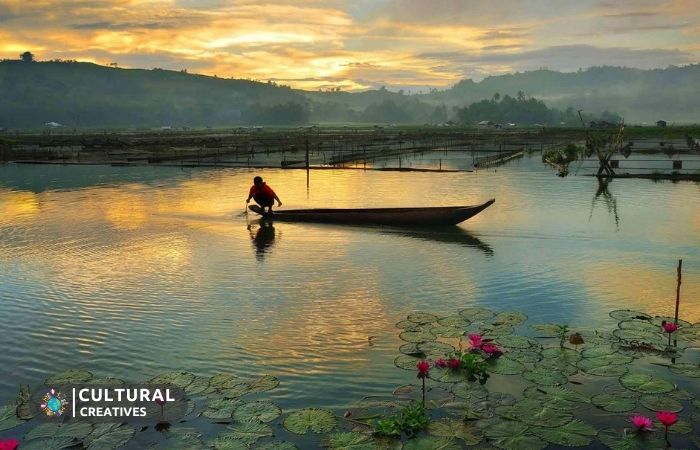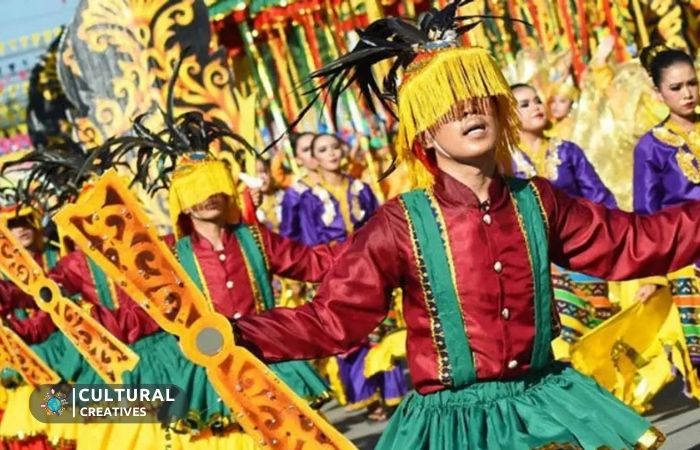The Kadayawan Festival is an annual celebration in Davao City, Philippines, honoring the city’s indigenous people. The festival usually occurs in the third week of August, showcasing cultural heritage and bountiful harvests.
Mark your calendars for the Tnalak Festival, a cultural feast that spotlight’s South Cotabato’s history and traditions. Taking place every year in July, this jubilant event commemorates the Foundation Anniversary of South Cotabato Province. It derives its name from T’nalak cloth, a traditional woven material created by the T’boli tribe, which symbolizes peace, unity, and cultural pride.
Crowds from all walks of life gather to experience the colorful parades, traditional dances, and indigenous music defining the celebration. Visitors can indulge in regional delicacies, appreciate expertly crafted artisan wares, and witness the diverse cultural expressions of the T’boli, Blaan, and Ubo tribes. Through its unique blend of festivities, it creates a tapestry of cultural richness that echoes the harmonious spirit of the people of South Cotabato.
A Tapestry Of South Cotabato’s Heritage

Every year, the rich culture of South Cotabato comes alive in the colorful Tnalak Festival, a celebration that honors the province’s indigenous heritage and the time-honored tradition of T’boli weaving. This festival not only serves as a display of the mesmerizing artistry of the T’boli people but also reinforces their cultural identity and the local community’s dedication to preserving their ancestral crafts. The streets bloom with vivid hues and the sounds of traditional music and dance as the entire province unites in a festive mood.
The Origins Of Tnalak Festival: Celebrating T’boli Weaving Traditions
The festival finds its roots in the age-old weaving practices of the T’boli tribe, who reside within the enchanting landscapes of South Cotabato. Central to the festival is the eponymous Tnalak cloth, a material of deep cultural importance and artistic excellence. It’s woven from abaca fibers, dyed with natural materials, and bestowed with intricate, dream-inspired patterns that are unique to each weaver. This celebration conveys respect and acknowledgment to the Dreamweavers, the women who skillfully turn their visions into tangible and invaluable cultural heirlooms.
The Indigenous T’boli People
Tnalak Festival transcends mere festivity; it represents the heartbeat of the T’boli culture. The event is a platform for the indigenous T’boli people to showcase their history, beliefs, and way of life through various activities and rituals. Participation extends from the local community to visitors, offering a deep dive into the T’boli’s symbolic universe. From intricate dance performances to traditional music, and from crafts to martial arts, the festival encapsulates the spirit and perseverance of the T’boli people to maintain and cherish their ancestral heritage in an ever-modernizing world.
Colors, Rhythms, And Activities

The festival explodes in a display of culture and heritage, an event that captivates the senses with its rich tapestry of colors and rhythms. This annual festivity commemorates the foundation of South Cotabato Province in the Philippines and pays homage to the indigenous T’boli tribe’s traditional art of Tnalak weaving. Each aspect of the festival, from the dynamic street dances to the intricate craft exhibitions, tells a part of the T’boli story, inviting locals and visitors alike to plunge into an immersive cultural experience like no other.
The Street Dancing And Costumes
Throngs of dancers, donned in elusively designed costumes, take to the streets moving rhythmically to the beats of indigenous instruments. These ensembles are a feast for the eyes, featuring a wide array of colors that represent various elements of T’boli culture and heritage. Spectators find themselves in a sea of reds, yellows, and royal blues, each shade a symbolic hue used in the Tnalak fabric. Beads, brass, and accessories complement the visual spectacle, creating a kaleidoscopic effect that accentuates the important traditions of the T’boli people.
Tnalak Weaving Exhibitions: Showcasing Artistry And Skill
- Vivid Tnalak cloth displays
- Live weaving demonstrations
- Workshops on T’boli craft techniques
- Cultural narratives and stories
At the heart of the festival, Tnalak weaving exhibitions take center stage. Artisans, adept in the age-old tradition, showcase their intricate designs and weaving skills. Attendees witness the transformation of abaca fibers into the storied Tnalak cloth, a process steeped in cultural significance and meticulous craftsmanship. The exhibitions are not only visually enthralling but also educational, providing insights into the symbolic meanings behind the woven patterns that are unique to this community.
Competitions And Cultural Shows
The festival is a pulsating hub for talent and cultural exchange, featuring various competitions such as traditional music, instrumental ensembles, and even modern renditions. Local artists and performers showcase their abilities, telling their narratives through powerful performances. The contests create a spirited atmosphere, nurturing a sense of pride among participants and fostering cross-cultural interactions among attendees.
Beyond The Festivities

While the Tnalak Festival paints the town with a palette of hues and traditional dances, its effervescent impact resonates far beyond the sights and sounds of the celebration. It fosters an environment where economic growth and cultural heritage flourish hand in hand. Let’s delve into the festival’s multifaceted imprint on South Cotabato’s community and its far-reaching fingers on tourism, local businesses, and cultural education.
Economic Benefits For South Cotabato
It is a potent stimulant for economic vigor in South Cotabato. Throngs of tourists bring a significant uptick in demand for hospitality and services, benefitting a broad spectrum of local businesses, from hotels and restaurants to street vendors and souvenir shops. This surge in activity not only boosts income but also fosters job creation, making way for a more prosperous community.
- Raised occupancy rates in hotels and other accommodations
- Enhanced sales for local craftsmen and artists
- Growth in food and beverage sector with increased dining out
The wave of tourism catalyzed by the Tnalak Festival significantly contributes to the local economy, with visitors from across the globe indulging in regional specialties, thereby broadening the market reach for indigenous products.
Cultural Preservation And Education
Amidst the colorful parades and rhythmic drumbeats, the festivals plays a critical role in the preservation of the T’boli culture, showcasing the intricate art of T’nalak cloth weaving—an emblem of tradition and identity for the T’boli tribe. The festival becomes a live classroom, educating both locals and tourists on the rituals, lore, and ancestral customs, directly contributing to the retention of intangible cultural heritage.
- Exhibitions and workshops highlighting T’boli artistry
- Demonstrations of traditional practices and craftsmanship
- Interactive sessions with elders sharing stories and histories
The festival not only honors the heritage but also kindles a sense of pride among younger generations, ensuring that the fabric of their history remains unblemished for years to come.
Related: 31 other Festivals in Philippines you will enjoy.
Challenges And The Future: Balancing Modernity With Cultural Integrity
The path into the future brings about challenges that hinge upon the critical balance between embracing modernity and maintaining cultural integrity. Rapid commercialization poses a threat to the T’boli’s cherished practices, risking the dilution of authenticity in favor of touristic appeal. To safeguard the sanctity of the Tnalak Festival, a collective effort is required.
| Challenge | Future Strategy |
|---|---|
| Maintaining authenticity amidst commercial influences | Implementing regulatory frameworks for festival events |
| Environmental sustainability of the festival | Initiating eco-friendly practices and waste management |
| Engaging the youth in cultural traditions | Integrating cultural education in schools and communities |
Striking this equilibrium ensures that the Tnalak Festival continues to be a beacon of cultural identity, not only celebrating the past but also forging a sustainable and future.
Conclusion
The Tnalak Festival stands as a testimonial to South Cotabato’s rich tapestry of culture. It invites us yearly, weaving a colorful celebration of tradition, unity, and community spirit. As we close this chapter, let us carry the festival’s vibrancy in our hearts, yearning for the next jubilant gathering.
Discover, celebrate, and cherish Tnalak – a cultural gem of the Philippines.


